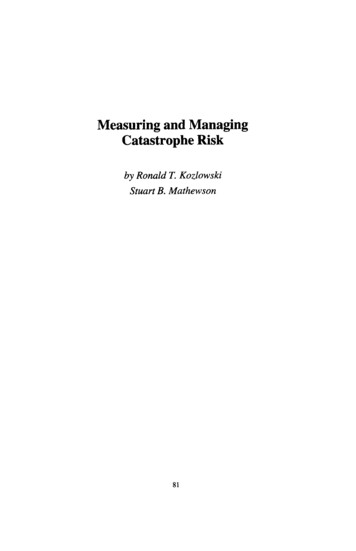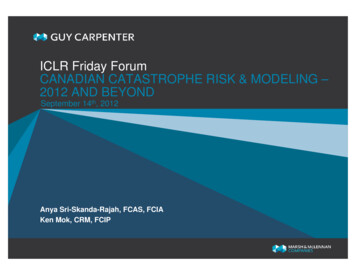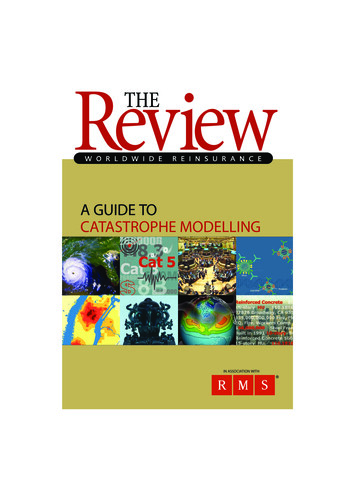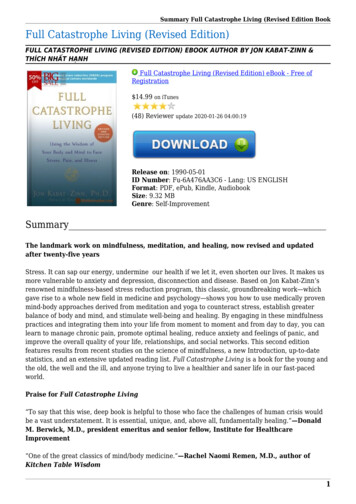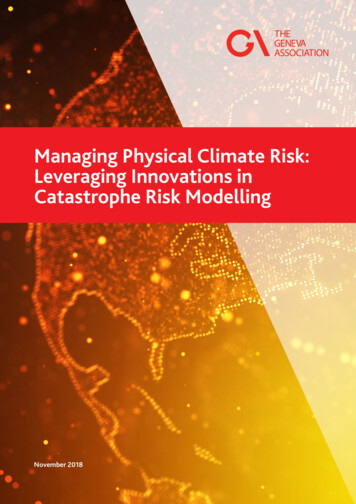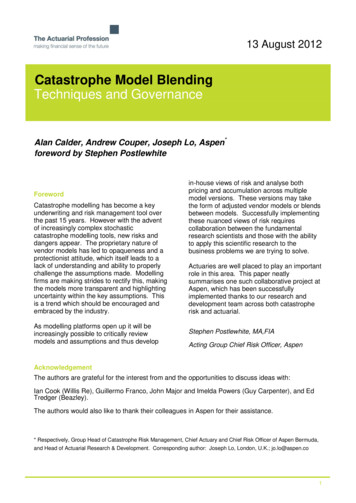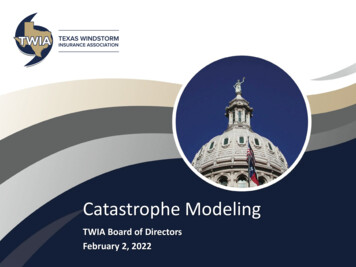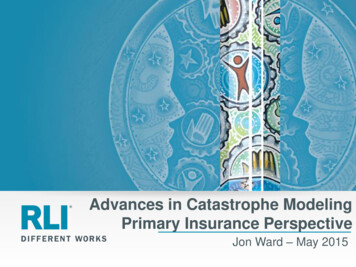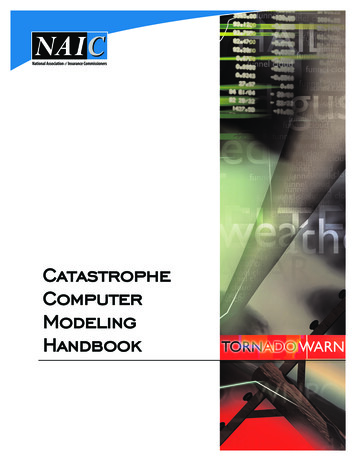
Transcription
CatastropheComputerModelingHandbook
Catastrophe ComputerModeling HandbookPrepared by theCATASTROPHE INSURANCE WORKING GROUPof thePROPERTY AND CASUALTY INSURANCE (C) COMMITTEENovember 2010
The NAIC is the authoritative source for insurance industry information. Our expert solutions support the efforts ofregulators, insurers and researchers by providing detailed and comprehensive insurance information. The NAICoffers a wide range of publications in the following categories:Accounting & ReportingAccountants, members of the insurance industry andeducators will find relevant information about statutoryaccounting practices and procedures.Statistical ReportsInsurance industry data directed at regulators, educators,financial analysts, insurance industry members, lawyersand statisticians.Consumer InformationConsumers, educators and members of the insuranceindustry will find important answers to common questionsin guides about auto, home, health and life insurance.Supplementary ProductsAccountants, educators, financial analysts, insurers,lawyers and statisticians will find guidelines, handbooks,surveys and NAIC positions on a wide variety of issues.Financial RegulationAccountants, financial analysts and lawyers will findhandbooks, compliance guides and reports on financialanalysis, state audit requirements and receiverships.Securities Valuation OfficeProvides insurers with portfolio values and proceduresfor complying with NAIC reporting requirements.LegalState laws, regulations and guidelines apply to membersof the legal and insurance industries.NAIC ActivitiesInsurance industry members will find directories,newsletters and reports affecting NAIC members.White PapersAccountants, members of the insurance industry andeducators will find relevant information on a variety ofinsurance topics.For more information about NAICpublications, view our online catalog at:Special StudiesAccountants, educators, financial analysts, members ofthe insurance industry, lawyers and statisticians will findrelevant products on a variety of special topics.http://store.naic.org 2001, 2011 National Association of Insurance Commissioners. All rights reserved.ISBN: 978-1-59917-412-9Printed in the United States of AmericaNo part of this book may be reproduced, stored in a retrieval system, or transmitted in any form or by any means, electronic ormechanical, including photocopying, recording, or any storage or retrieval system, without written permission from the NAIC.NAIC Executive Office444 North Capitol Street NW, Suite 701Washington, DC 20001202.471.3990NAIC Central Office2301 McGee Street, Suite 800Kansas City, MO 64108-2662816.842.3600NAIC Securities Valuation Office48 Wall Street, 6th FloorNew York, NY 10005-2906212.398.9000
Companion ProductsThe following companion products provide additional information on the same or similar subject matter. Manycustomers who purchase the Catastrophe Computer Modeling Handbook also purchase one or more of thefollowing products:Consumer's Guide to Earthquake InsuranceDesigned to educate consumers about the need to consider purchasingearthquake insurance. Helps consumers understand what earthquake policiescover and how they work. Also includes information on smart shoppingstrategies and steps to take in protecting homes. Illustrates the seismic riskthe country faces and facilitates financial preparedness through anunderstanding of earthquake insurance.Final Report of the Earthquake Study GroupOutlines the work of a group appointed to study the earthquake peril,specifically the differences between west coastal earthquakes andearthquakes in the central United States. Provides recommendations to helpmitigate insurance losses caused by earthquakes. Identifies strategiesto communicate loss-mitigation measures to insurers and consumers.NAIC Disaster Reporting FrameworkSuggests approaches and concepts to assist regulators in providing efficientand effective insurance regulation during a disaster. Provides guidance tohelp state insurance departments communicate a disaster-reporting effort toinsurers, perform solvency and market conduct analysis on insurers, andstreamline the process of gathering information from insurers to preventduplicative data requests.The Potential Impact of Climate Change on Insurance RegulationWritten under the assumption that global warming is occurring, this whitepaper provides an overview of climate change concerns related to insuranceand insurance regulation. It presents issues faced by the various lines ofbusiness and ways regulators can mitigate these potential problems.Investment implications and opportunities, the government's role, and theimportance of enhanced disclosure also are covered.State Disaster Response PlanServes as a guide for state insurance regulators as they develop and adoptcomprehensive disaster response plans. Represents the collective efforts ofthe NAIC membership to share best practices and learn from one another ineffectively preparing for and reacting to catastrophic events.International orders must be prepaid, including shipping charges. Please contact an NAIC Customer Service Representative, Monday - Friday, 8:30 am - 5 pm CT.
TABLE OF CONTENTSSection IPurpose and Background .1Purpose.1Background .1Insurers’ Perspective.2Catastrophe Modelers’ Perspective.3Consumers’ Perspective.3Regulators’ Perspective .4Section IISelected Catastrophe Perils.7Earthquake .7Hurricane.9Section IIIGeneral Overview of Catastrophe Models .11Frequency and Severity.11Science Module.11Engineering Module.12Insurance Module.12Section IVModel Input Provided by Company.13Section VModel Output .15Average Annual Losses .15Loss Costs .15Distribution of Losses .15Exceeding Probability Distribution.16Individual Event Losses.16Historical Event Losses.16Section VIModel Validation and Update.17Accuracy .17Comparison to Historical Information .17Convergence .17Expert Opinion/Peer Review .17Input Data Provided by Company.17Logical Relationship to Risk.18Model Updates .18Probabilistic Range .18Real-Time Predictions .18Sensitivity .18Stability .18Section VIIEvaluating Models .19General Questions.19Questions Specific to Earthquake Modelers .24Questions Specific to Hurricane Modelers .26i
Section VIII Regulatory Review and Acceptance .29Section IXRelated Activities, Activities to Consider, Education and Outreach .31Related Activities.31Actuarial Standard for Model Use .31Pre-Tax Loss Reserves for Companies .31Activities to Consider .31Auditing Company Exposure Data .31Exposure Default Values .32Multi-State versus Individual State Review .32Multi-State Considerations .32Individual State Considerations .33Education and Outreach.33APPENDICESAppendix 1Appendix 2Appendix 3Appendix 4Appendix 5Appendix 6Appendix 7Appendix 8Appendix 9Appendix 10Appendix 11Appendix 12Appendix 13Appendix 14Appendix 15Appendix 15aAppendix 16Appendix 16aAppendix 17Appendix 18Working Definitions .35Model Data Sources and Documentation .37Model Results .41List of Modeler Contacts .49State Insurance Department Contacts .55List of Enacted Legislation by State .65Florida Commission on Hurricane Loss Projection MethodologyReport of Activities as of Nov. 1, 2009. 171Florida Department of Insurance Computer Model Letter of InquiryAs of Feb. 11, 1999 .173Louisiana Insurance Rating Commission Computer Model Interrogatories .413California Earthquake Authority.417Florida Department of Insurance Non-Disclosure Agreement Sample .419Earthquake Interrogatories.421Earthquake Study Group’s Earthquake Insurance Computer ModelCertification and Interrogatories .427Arkansas Act 1343 Establishing Arkansas Earthquake Authority .433New York Circular Letter No. 7 (1998)—April 30, 1998The Use of Computer Simulation Models in Homeowners’Insurance Rate Development .435New York Circular Letter 1993-11Guidelines for Homeowners Insurance Along New York Coastal Areas andSpecial Report Pursuant to Section 308 of the Insurance Law andSupplements 1 and 2 .437Puerto Rico Circular Letter AC-II-1-1366-95, Jan. 25, 1995,Catastrophic Insurance Loss Reserve .481Puerto Rico Circular Letter AC-II-9-1360-94, Act No. 73 ofAug. 12, 1994, Internal Creation to Establish Reserve forPayment of Losses of Catastrophic Insurance .483South Carolina Bulletin 96-5, Coastal Property Insurance.487Texas Bulletin B-0037-00, Use of Catastrophe Models in RatemakingJune 9, 2000 .493ii
SECTION IPURPOSE OF THE HANDBOOK AND BACKGROUND INFORMATION ONCATASTROPHE COMPUTER MODELINGPURPOSEThe purpose of the Catastrophe Computer Modeling Handbook (Handbook) is to explore insome detail catastrophe computer models and to discuss issues that have arisen or can beexpected to arise from their use.The NAIC, in this Handbook, does not take a position as to the ultimate soundness of catastrophecomputer models or the interpretation of the results derived therefrom, but attempts toobjectively discuss the issues related to and the ramifications of catastrophe computer models.The guidance offered in this Handbook is advisory only and is not intended to prescribemandatory regulatory procedures. The guidance is not intended to be all-inclusive; rather, itsuggests areas and concepts that should be considered and explored in order to become wellinformed about catastrophe computer models.The Handbook also includes as appendices detailed information about specific modelers, stateand modeler contacts, enacted state legislation, the Florida Hurricane Fund and the CaliforniaEarthquake Authority.This Handbook will be revised as necessary to incorporate new developments and to provideadditional guidance and information. The Catastrophe Insurance Working Group of the PersonalLines—Property and Casualty Insurance (C) Committee is charged with the responsibility ofconsidering and recommending to the members of the NAIC revisions to this Handbook.BACKGROUNDExposure to catastrophe losses has been a topic that has garnered much attention from theinsurance community since Hurricane Andrew. Other significant reminders like HurricanesHugo and Iniki, as well as the Northridge and Loma Prieta earthquakes, have served to focusattention on property insurers’ significant exposure to catastrophe losses. These eventshighlighted the potential inadequacies of traditional empirical methods of quantifying thatexposure.The NAIC began to study issues related to catastrophes in March 1993 with the appointment ofthe Catastrophe Insurance Working Group by the Personal Lines Property and CasualtyInsurance (C) Committee. The committee is charged with providing a forum for discussingvarious issues related to catastrophe modeling and to monitor issues that will result in changes tothe Catastrophe Computer Modeling Handbook. The Personal Lines—Property and Casualty (C)Committee initially delegated responsibility for this charge to the Catastrophe ModelingSubgroup, one of two subgroups which were appointed to assist the Catastrophe InsuranceWorking Group. The subgroup has since been discharged and the Catastrophe InsuranceWorking Group completed drafting. This effort has taken slightly longer than originallyanticipated. Hopefully the end result was worth the wait. 2011 National Association of Insurance Commissioners1
Insurers’ PerspectiveInsurers continually seek ways to more accurately measure the risk of loss to which they areexposed. Before 1992, insurers generally believed that their probable maximum loss, in theaggregate, was much less than the actual insured losses caused by Hurricane Andrew. Insurersbegan to realize that the application of standard catastrophe ratemaking methodologies based onhistorical losses of 25 to 30 years of data were inadequate for low frequency, high severity perilssuch as hurricanes and earthquakes. Hurricane Andrew cost insurers 16.5 billion, but that wasnot the “Big One.” Had Hurricane Andrew struck the coast 25 miles to the north, the insured losspotential would have been in the 50 billion range. Andrew caused major market deteriorationfor the citizens and insurance regulators in Florida. Insurers came to the stark realization thattheir companies’ assets were much more exposed than previously believed. The potential for losscontinues to cause availability problems for coastal states particularly states that have notexperienced hurricanes in recent years.As insurers seek to measure their potential loss exposure, they are motivated to raise prices towhat they consider to be adequate levels or to reduce their exposure. If insurers believe that theirproducts are inadequately priced, they will attempt to raise the prices to levels they believe to beadequate. If regulators resist these price changes, insurers may withdraw from the market anddivert capital to other lines of business. From the insurers’ viewpoint, they are not attempting topunish consumers or make life difficult for insurance regulators. They are simply trying toprotect capital and surplus.In the past, property insurance rates have typically included a factor to reflect exposure fromcatastrophe loss. The typical ratemaking procedure called for capping catastrophe losses at aselected figure and then averaging the excess losses over a long period of time. The time periodranged from 10 to 30 years in duration. History has proven to be a good predictor of the future aslong as there are no significant changes in the environment in which the coverage is to beprovided and a time period that provides a sufficient number of catastrophes is used. Manyinsurers believe that past property insurance catastrophe loadings are no longer needed in areasthat are subject to significant catastrophe losses. In addition, it is possible that weather patternsare changing. Insurers argue that using old ratemaking methods underestimate the cost ofinsuring catastrophe prone areas.The problem with using relatively short periods of historical catastrophe losses, such as 25-30years of insurers’ data, is as follows: A very long history is needed in order for it to be reflective of all the expected futurehurricanes or earthquakes that are likely to occur. On the geologic, climatic and seismictimeframe, 100 years is not a lot of time, however 100 years of recorded scientificinformation is significant. When smaller geographic areas are considered, the availablehistory of such events is even more problematic. Also, the traditional method does not takeinto account the full spectrum of possible catastrophes that could befall any particulargeographic location. Some events have a “return period” of 50, 100 or even 250 years ormore and would not be taken into account using the traditional method; Historical losses are reflective of the exposed structures (both as to numbers and their value)that were there when the historical events took place and not of what are currently exposed—what insurers believe is needed is a means to measure the loss impact on the exposures that 2011 National Association of Insurance Commissioners2
will be exposed at the time of the expected event, reflecting both the growth in the numbersof insureds living in “harm’s way” and the higher values of the structures built in theselocations; People have been and still are building more dwellings and businesses in areas that aresubject to significant catastrophe losses, casting doubt on the validity of historical lossfigures in projecting future loses since fewer buildings were then subject to loss; Building codes and building practices have been more focused on life safety than onproperty preservation and have not kept pace with the changes in construction methods. Inaddition, there are conflicting interests for the construction and real estate developmentcommunities versus those of insurers, reinsurers and emergency management agencies oftencreating situations where owners and occupants are not adequately aware of the risk they arefacing until it is too late; and When only the most recent historical period is used, losses can be over- or underestimated.What is needed is a methodology that creates stability in ratemaking to prevent unnecessaryfluctuations in the premiums charged to policyholders. Many insurers believe thatcatastrophe modeling provides that stability.Advances in technology in recent years have enabled insurers and reinsurers to apply computermodeling to estimate the effect catastrophe losses could have on their books of business. Theresults of these models are used to assist with decisions about where an insurer will choose towrite business and how much to charge for business written. Some insurers are replacing thetraditional catastrophe loading in rate filings with numbers supported by computer models.Catastrophe Modelers’ PerspectiveApplication of catastrophe modeling is relatively new to property insurance. Catastrophemodelers have significant investments in these models and are, as a result, somewhat guarded inthe information they publicly disclose about their models. They are doing what any prudentbusinessperson would—protecting a business asset from disclosure to competitors. As insurersare requested to provide information so that regulators can determine if the processes applied arelogical and result in rates that reasonably reflect expected future loss costs, pressure is placed oncatastrophe modelers to demonstrate that their models produce results that are acceptable to theregulators. Catastrophe modelers are being called upon to disclose information about elementsused in their models and how data provided by an insurer is used. It is now incumbent upon themodeling firms to share enough information with regulators so that they can perform theirregulatory duties to assure that rates are not excessive, inadequate, or unfairly discriminatory.Consumers’ PerspectiveConsumer representatives are skeptical about the application of computer models to propertyinsurance rates and underwriting decisions. There has been a perception that the insurers arehiding behind a cloak of mystery that is held by the catastrophe modelers. The consumerrepresentatives know that a great deal of public information goes into the models, yet themodelers’ claim the models are confidential and will not show consumer representatives howthey work. This cloak of mystery and the varying results produced by catastrophe models tend tomake consumer representatives wary. They often oppose including a catastrophe rate based on 2011 National Association of Insurance Commissioners3
confidential models. In states where consumer representatives are allowed to intervene in ratecases, they have sometimes hired their own experts to challenge the rates filed by an insurer.Consumers have legitimate questions about the effects of the use of computer models on theirinsurance bills. In Florida, homeowners’ rates have increased more than 100 percent sinceHurricane Andrew. In addition, coverage for hurricane has been reduced with higher deductiblesand lower effective policy limits. Yet, there are still many areas where availability andaffordability remain problematic.Some of the areas where consumers have not received satisfactory explanations are: Why their premiums may differ depending on which model is used; Why the geographic groupings seem arbitrary; Why contiguous counties or territories may have very different costs; Why a method with so much uncertainty is assumed to be correct to the exclusion of othermethods. This can be particularly confusing since previous assumptions about expected costswere also purported by companies to be accurate enough for ratemaking; Why a model’s estimates do not always match closely to actual storms; Why models that seem to overestimate large storms are allowed to be used; Why rates keep increasing even after significant increases have already been incorporated; Why the probability of a large hurricane in any given year is very small, yet premiums paiddo not appear to generate any investment returns that benefit policyholders; and Why premiums are based on expected annual losses, yet many of the assumptions seem to bebased on 250 or 500 years of generated experience for a location at the current time.Consumer representatives call for public disclosure of the input and output from catastrophemodels so independent tests can be run to assure that model results are reasonable.Regulators’ PerspectiveRegulators are faced with an extraordinary challenge as they attempt to reconcile the vagaries ofmodel-based loss costs with the obligation to assure that the resulting rates are appropriate andfacilitate a vibrant industry. Regulators must weigh the relative merits of replacing a traditionalmodel that has evolved very methodically over the years with a methodology that is in its relativeinfancy in terms of producing reliable results.The table that follows highlights the wide range of answers obtained from catastrophe models’estimations of expected loss costs. 2011 National Association of Insurance Commissioners4
CountyDadeDeSotoDixieDuvalEscambiaFlaglerModel 12.200.210.260.20.038.044Model 21.710.530.260.310.490.35Model 31.690.320.130.080.820.19Model 42.860.270.110.071.070.14Model 070.44Lowest1.690.140.110.070.160.14These numbers are expected loss costs per 1,000 of insurance that were provided to the FloridaCommission on Hurricane Loss Projection Methodology. Inputs were the same for every modeland each of the models was subjected to the same standards. Yet the highest modeled loss costswere almost seven times as high as the lowest within a county.Regulators are reluctant to embrace the use of models for ratemaking without demandinganswers to some relevant questions, given such a wide range of results.Initial attempts by regulators to gain information about catastrophe models were met withcaution by insurers and the entities that have developed the models, in part due to claimsregarding the propriety and confidential nature of some aspects of the models. The typicalregulatory response was to disapprove the filing containing the model results, since regulatorswere unable to obtain information necessary to evaluate the appropriateness of model output fora rate filing. Even now, no modeler has requested advisory organization status for use of its losscosts, which could facilitate model output use in ratemaking.Most modelers have agreed to share basic information with regulators who have requested it.Regulators have been allowed to look at model input and output and review some formulas andalgorithms within the model. This happens after an agreement is reached with a modeling firmabout what will and will not be made part of the public record. Regulators recognize that somejurisdictions’ freedom of information laws require public disclosure of all information providedto them. Both regulators and modelers are working to meet the challenge of providing enoughdisclosure to make informed decisions, while preserving the confidentiality of proprietarydetails. This handbook is an important step in that process.Regulators are trying to better understand catastrophe models and their applications to insurers’books of business. These applications include underwriting, ratemaking and solvencymonitoring. Regulators are constantly seeking new sources of information and objectiveguidance in understanding model input, output and methods. 2011 National Association of Insurance Commissioners5
2011 National Association of Insurance Commissioners6
SECTION IISELECTED CATASTROPHE PERILSThe basic physical characteristics of natural phenomenon must be understood to see howmodelers develop assumptions about the characteristics of each catastrophic event. Thishandbook addresses the hurricane and earthquake perils. Models are used for other perils as well,such as non-hurricane wind. However, it is these two types of events that are the mostcontroversial.Much of the uncertainty about potential damage is caused by the low frequency of hurricanesand earthquakes. This adds uncertainty to projections of future insured loss estimates. Otherinsurance, such as private passenger auto, need relatively short periods of time to generatereliable data. Accurate estimates can be calculated with traditional mathematical and statisticaltechniques. When dealing with these, the time span that is meaningful is so long that accuraterecords do not exist of frequency or severity of events. It is this lack of recorded data combinedwith the potential severity of the events that creates the challenges of estimating the impacts ofcatastrophes.EarthquakeAn earthquake is a shaking of the ground caused by the sudden breaking and shifting of largesections of the earth’s rocky outer shell. A severe earthquake may release energy 10,000 times asgreat as that of the first atomic bomb. Rock movements during an earthquake can make riverschange their course. Earthquakes can trigger landslides that cause great damage and loss of life.Large earthquakes beneath the ocean can create a series of huge, destructive waves calledtsunamis that flood c
the Catastrophe Insurance Working Group by the Personal Lines Property and Casualty Insurance (C) Committee. The committee is charged with providing a forum for discussing various issues related to catastrophe modeling and to monitor issues that will result in changes to the Catastrophe Computer Modeling Handbook.
